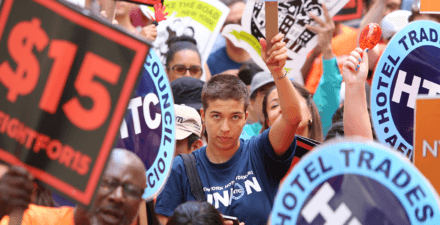Understanding how raising the federal minimum wage affects income inequality and economic growth
Heather Boushey, Executive Director and Chief Economist, Washington Center for Equitable Growth, testifying before the U.S. Senate Committee on Health, Education, Labor, and Pensions on “From Poverty to Opportunity: How A Fair Minimum Wage will Help Families Succeed”
March 12, 2014
Introduction
I would like to thank Chairman Harkin, Ranking Member Alexander, and the rest of Committee for inviting me here today to testify.
My name is Heather Boushey and I am Executive Director and Chief Economist of the Washington Center for Equitable Growth. The center is a new project devoted to understanding what grows our economy, with a particular emphasis on understanding whether and how high and rising levels of economic inequality affect economic growth in our nation.
By training, I am a labor economist. I have spent my career seeking to understand the American labor market and the effects of public policy on family economic well-being and the economy more generally. It is an honor to be invited here today to discuss how a fair minimum wage will help families succeed and support broad-based income growth in our society.
The best way to fight poverty is to make sure people have jobs with decent wages that put them above the poverty line. Raising the minimum wage and ensuring that its value stays at a reasonable level over time through indexing it to the cost of living will establish a stronger first rung on the ladder to economic security. The minimum wage is the cornerstone of a set of policies, including the Earned Income Tax Credit, the Affordable Care Act, as well as some yet to be implemented nationwide, such as paid sick days and paid family and medical leave that provide the foundation for economic security for workers and their families.
There are three key conclusions from my testimony:
- Raising the minimum wage will reduce poverty. According to economic estimates, raising the minimum wage to $10.10 an hour will reduce the poverty rate for non-elderly Americans to 15.8 percent by 2016 from current 17.5 percent levels. This increase would bring about 6.8 million people out of poverty.
- Raising the minimum wage will help family breadwinners support their children. The typical minimum wage earner brings in half of their family’s income. Congress should also take care to make sure that other benefits for low-wage workers provide a full package for low-wage workers and their families as families will also need help with access to affordable and quality health care, childcare, and housing, even at a higher minimum wage.
- Raising the minimum wage will have positive economic effects above and beyond lowering the poverty rate. Economic research points to the conclusion that a higher minimum wage does not cause greater unemployment, boosts productivity, and addresses the growing problem of rising income inequality.
The rest of my testimony will focus on the facts about the minimum wage, a review of the academic literature on the impact on poverty of raising the minimum wage, and a consideration of how the minimum wage interacts with other poverty-fighting programs to help low-wage workers enter the middle class.
The state of the minimum wage
The federal minimum wage is currently $7.25 an hour, where it’s been since July 2009. Raising the minimum wage to $10.10 would be in line with its value in the past. The minimum wage has been raised 22 times since first enacted into law in 1938, most recently in three steps between 2007 and 2009.
The Fair Minimum Wage Act of 2013 would raise the minimum wage to $10.10 in three steps, beginning three months after passage of the bill and ending two years after the first increase. The law will then index the minimum wage to the rate of inflation, ensuring that its value does not erode over time. It will also raise the minimum wage for workers who earn tips, such as food service workers, to $7.10 an hour.
The Fair Minimum Wage Act is necessary because Congress has allowed the purchasing power of the minimum wage to decline sharply in recent years, leaving too many workers toiling full-time, but not able to rise above poverty. The purchasing power of the minimum wage hit a high in 1968 and has declined by 23 percent since then in inflation-adjusted dollars, using the Bureau of Labor Statistics Consumer Price Index for all Urban Consumers Research Series.
The value of the minimum wage also has declined relative to the earnings of other wage earners. In 1968, the minimum wage was equal to just over half (53 percent) of the average wage for production and non-supervisory workers. In 2013, the minimum wage had fallen to just over a third (36 percent) of the average wage. (See Figure 1.)

The Fair Minimum Wage Act sets the minimum wage at a level that will help workers and their families, be good for the economy, and is consistent with past levels of the minimum wage. If the minimum wage had been indexed to inflation starting in 1968, it would currently be $9.39. And if the minimum wage were indexed to be 50 percent of the average wage, roughly where it was in 1968, it would currently be $10.08. In inflation-adjusted dollars, by 2016 when the Fair Minimum Wage Act would be fully implemented, the minimum wage would equal about $9.45 in today’s dollars, consistent with past values. (See Figure 1.)
This proposed increase in the minimum wage is consistent with what the economy can provide. While the minimum wage has lost value in inflation-adjusted dollars, the overall economy has grown considerably. Between 1968 and 2013, U.S. gross domestic product grew by an inflation-adjusted 245 percent, to $15.8 trillion from $4.6 trillion while the inflation-adjusted value of the minimum wage fell by 23 percent over the same period. Or consider another means of comparison, from 1968 to 2012, the average pre-tax, pre-transfer income of the top 1 percent of households grew by 187 percent. In contrast, over the course of those same years, the share of U.S. families living under the poverty line has risen from 10 percent to 11.8 percent
Even after the increase proposed in this law, the federal minimum wage will remain a floor. Individual states and municipalities have minimum wages above the federal minimum of $7.25. Twenty-one states and the District of Columbia have higher minimum wages, with the state of Washington having the highest in the country at $9.32 per hour. We have learned from these experiences of these states that raising the minimum wage overall delivers of positive results in the fight against poverty and efforts to grow the middle class from the bottom up.
Earnings of minimum-wage workers and poverty thresholds
Raising the minimum wage is an important anti-poverty tool, but the current minimum wage leaves too many families in poverty. Earning the current federal minimum wage, a minimum-wage earner working 40 hours a week every week of the year would earn $15,080 over the year. This amount of earnings puts a single adult just barely above poverty. But if that worker has to support any other people—such as a child—then this family would be living below the U.S. poverty threshold. The poverty line for a family with one non-elderly adult and one child was $16,057 in 2013. Therefore, a full-time minimum-wage earner with one child and no spouse would come up short by $977 each year.
Increasing the minimum wage to $10.10 by 2016, which would equal $9.45 in 2013 dollars, would boost the earnings of low-wage workers and reduce poverty. At that minimum wage, a full-time, full-year worker would earn $19,656 in 2013 dollars over the course of the year, assuming they never take a day off without pay, and be able to support two children as a single earner and be above the official poverty threshold.
Nearly a quarter (23 percent) of the workers who will benefit from the Fair Minimum Wage Act currently live in a family earning less than $20,000 in a year, just above the poverty threshold of $18,769 for a family of one adult and two children. Just under 52 percent of workers who will benefit live in a family making below $40,000 a year, which is closer to what many surveys show is what people believe is a basic standard of living for a family of four.
Economists have also explored with the likely effects of raising the minimum wage would be on poverty. Economist Arindrajit Dube, from the University of Massachusetts, Amherst, estimates that a 10 percent increase in the minimum wage would immediately decrease the poverty rate by 2.4 percent and lead to an overall reduction of 3.6 percent in the longer run. According to his estimates, which in my view are empirically sound and conform with the economics literature, the Fair Minimum Wage Act will reduce the poverty rate for non-elderly Americans from 17.5 percent to 15.8 percent. On a longer time frame, past one year after the minimum wage increase, the rate would decrease to 15 percent, according to Dube.
In more concrete numbers, the increase would translate to around 4.6 million Americans no longer in poverty (or around 6.8 million if longer term effects are accounted for). Another way to contextualize these numbers is to note that the poverty rate for the non-elderly increased by as much as 3.4 percentage points during the Great Recession. So the proposed minimum wage increase could reverse about half of that increase. Other recent research shows that an increase in the minimum wage would reduce spending on anti-poverty programs like the Supplemental Nutrition Assistance Program.
Making work pay
The anti-poverty effects of the minimum wage are significant, but to pull workers and their families up and out of poverty, the minimum wage must work in tandem with income support policies. One of the most important policy interactions is with the Earned Income Tax Credit. The EITC is a refundable tax credit for low-income families that is larger for those with more dependent children. The EITC is an effective anti-poverty policy that lifts millions of Americans out of poverty. In 2012, the EITC lifted 6.5 million people out of poverty, according to the Center Budget and Policy Priorities.
For example, the minimum wage and the EITC are designed to work together. As economists David Lee, of Princeton University and Emmanuel Saez of University of California, Berkeley, argue the optimal minimum wage should be paired with a wage subsidy, such as the EITC. This wage subsidy encourages workers to enter the labor force and the minimum wage helps ensures they receive an adequate wage to escape poverty. Looking at the data, we can see how the minimum wage and the EITC work together to pull families out of poverty. At the current minimum-wage level, a single earner (full-time, full-year) with two dependents would receive $5,372 from the EITC for a total after-federal income of $20,452 (although workers may need to pay state income taxes and will owe payroll taxes). With a minimum wage of $9.45 in 2013 dollars, a single earner would see a $4,920 boost from the EITC for a total after-federal income tax of $24,576.
A major concern with the EITC, however, is that it is a subsidy to employers who pay very low wages. According to UC-Berkeley economist Jesse Rothstein’s estimates, employers capture 27 percent of the value of the EITC. The EITC induces more workers into the labor market and makes it easier for them more to take lower wages, since they can get the EITC subsidy. Part of this result is because EITC-eligible workers who can afford a lower wage compete against non-eligible workers. The result is that employers get labor at a cheaper rate than they would otherwise.
One very important reason to focus on raising the minimum wage is that a higher minimum wage reduces this capture by reducing the reduction in wages caused by the increase in the supply of labor. Making more workers eligible for the EITC would also help benefit workers. The end result is both greater employment and more of the EITC subsidy going to the intended recipients, low-wage workers and their families.
Low-wage workers are eligible for a variety of benefits aimed at boosting incomes or helping them afford basics, such as housing, health care, or childcare. This is important since many basics, especially health care, childcare, and housing, are too expensive at market rates for low-income workers and their families. Childcare alone can eat up a large portion of a minimum wage workers’ income. It is imperative that these programs work in tandem and that Congress—and state policymakers—consider the interaction effects of changing any of these policies. In many cases, the states set the rules for program eligibility, with some guidelines from the federal government, so engaging them in this conversation is a must.
In the mid-1990s when Congress implemented welfare reform, Congress did a very good job putting all these pieces together by looking at thebenefits and income supports for low-wage workers and their families as a package. Within a short span of time, Congress implemented welfare reform, while also raising the minimum wage, expanding the EITC, expanding access to children’s health through the State Children’s Health Insurance Program, and expanding childcare subsidies. Only by putting a full basket of policies together will low-wage workers be able to rise out of poverty and into the middle class. The minimum wage is a core piece of this puzzle, but it is not the only piece. (See Figure 2.)
Congress could do more to ensure that minimum wage workers earn a fair day’s pay by making sure that when they or their child gets sick they have the right to job-protected paid sick days, as proposed in the Healthy Families Act and is now the law in a number of municipalities and the state of Connecticut. Further, most minimum wage workers do not have the right to vacation time or paid family and medical leave, making it difficult for them to care for their families while working full-time.
Economic effects of raising the minimum wage
Raising the minimum wage is not only an effective anti-poverty tool but also a proven way to boost our economy more generally. The economics evidence shows that raising the minimum wage does not lead to higher unemployment overall but rather boosts productivity and addresses a growing issue in our economy of rising inequality.
Careful studies of the economics literature find that increases in the minimum wage have little to no effect on employment. Economists David Card, of the University of California, Berkeley, and Alan Krueger, of Princeton University, looked at the effects of a minimum wage hike in New Jersey by comparing fast food restaurant employment in the state to fast food employment in Pennsylvania which did not increase its minimum wage. Card and Krueger found that the increase in the minimum wage did not reduce employment. Their approach has been generalized in later research. Research by Arindrajit Dube, T. William Lester of the University of North Carolina – Chapel Hill, and Michael Reich of the University of California, Berkeley looked at all of the bordering counties that have different minimum wages between 1990 and 2006. They too found that minimum wage did not have a significant effect on employment.
One reason that employment has not been shown to fall due to raising the minimum wage is because higher wages can make workers more productive and therefore more valuable to their employer. Economists call this the “efficiency wages” theory. There is an extensive literature on efficiency wage theory, with notable contributions Nobel Laureates Joseph Stiglitz and George Akerlof, which suggest that paying more than the market-clearing wage can make firms more productive.
As the White House pointed out last week, higher wages can “boost productivity, increase morale, reduce costs, and improve efficiency.” Here are just two academic studies that prove these points. John Schmitt, a Senior Economist at the Center for Economic and Policy Research, finds empirical economics research suggesting efficiency gains. And in a 2011 study, Georgia State University economists Barry Hirsch and Bruce Kaufman, along with Tetyana Zelenska from Innovations for Poverty Action, examined the effect of a federal increase in the minimum wage on 81 restaurants in Georgia and Alabama. In their survey, managers reported that they could identify possible non-wage savings and productivity improvements in response to the minimum-wage regulations. It is possible that lower costs stemming from these changes could outweigh the costs of paying a higher minimum wage.
In addition, it’s possible that a higher minimum wage could make staying in one’s job more attractive and thus reduce turnover costs. A 2013 working paper by UMass-Amherst economist Arindrajit Dube, University of North Carolina, Chapel Hill economist William Lester, and UC-Berkeley economist Michael Reich finds that a higher minimum wage leads to fewer so called “hires and separations,” or worker turnover. Other empirical studies suggesting that a higher minimum wage—or a “living wage” covering basic needs—can reduce labor turnover include studies of workers in San Francisco(including airport and homecare workers) and Los Angeles. Lower turnover costs could potentially allow businesses to overcome the increased cost of paying a higher wage.
Finally, the level of the minimum wage has a considerable effect on the distribution of wages in the United States. As mentioned above, the minimum wage used to be much closer to the average wage. But since 1968, the average wage grew as the purchasing power of the minimum wage declined by 23 percent. At the same time, the distance between wage earner at the 10th percentile and median wage earner, or the earner at the 50th percentile, grew by 18 percent from 1979 to 2009.
Economists have found that the declining inflation-adjusted value of the minimum wage had a considerable effect on wage inequality for those workers in the bottom half of the wage distribution. A 1996 paper by economists John DiNardo, of the University of Michigan, Nicole Fortin, of the University of British Columbia, and Thomas Lemieux, also of the University of British Columbia, found that the decrease in the minimum wage from 1979 to 1988 had a considerable effect on the wage distribution. They found the decline over that time could explain up to 25 percent of the change in the standard deviation in the logarithm of male wages and up to 30 percent for female wages. In plain English, this means the decline in the minimum wage explained up to a fourth of increasing wage inequality for men and up to three-tenths of increase wage inequality for women.
In more recent work, MIT economist David Autor, London School of Economics economist Alan Manning, and Federal Reserve Board economist Christopher Smith find that about 75 percent of the increase in low-end inequality from 1979 to 1991 is due to the decline in the value of the minimum wage, but the decline only explains 45 percent of the increase from 1979 to 2009.
While the literature has not come to an agreement on the exact size of the effect, the decline of the minimum wage was a significant factor in the increase in inequality for lower half of the income distribution.
Who would be affected by a minimum wage increase to $10.10?
According to calculations from the Economic Policy Institute, approximately 28 million workers would see a raise if the minimum wage were raised to $10.10 by July 2016. The affected workers would include not only those making under $10.10 an hour, all of whom would see their wages directly increased, but also those earning just above $10.10. Due to a spillover effect, these workers would see their wages indirectly increased as employers try to maintain the previous relative status of workers in their firms.
The majority of affected workers, those directly and indirectly affected, would be women. Fifty-five percent of the affected workers would be women. For context, women represent 49.2 percent of total employment.
One invalid criticism of the minimum wage as an antipoverty tool is that the minimum wage would primarily benefit teenagers who are working part-time and are supported by their parents. The data, however, do not bear this story out. Contrary to stereotypes of minimum wage workers, 88 percent of affected workers would be adults. A plurality of affected workers, 36.5 percent, would be between the ages of 20 and 29. In fact, the average age of affected workers would be 35 years old.
And the minimum wage increase would not flow mostly to part-time workers. Fifty-three percent of affected workers would work full time, defined as at least 35 hours a week. And research finds that minimum wage hikes do not result in significant decreases in working hours. (See Figure 3.)

Then there are tipped workers, who earn a subminimum wage. They are similar to those who earn the minimum wage as they also are less educated, younger, and more likely to be female than the rest of the workforce.The Harkin-Miller legislation would raise the tipped minimum wage to 70 percent of the regular minimum wage. This increase would give tipped workers a considerable raise from the current tipped minimum wage of $2.13.
The families of minimum wage earners are also dependent upon the earnings of those workers. On average, the earnings of minimum wage earners are 50 percent of their family’s incomes.
Comments on CBO’s minimum wage report
Overall, the report by the Congressional Budget Office on the proposed minimum wage increases is well done. And that’s not a shock considering that it is written by the Congressional Budget Office. Their work is always high quality and a valuable contribution to the policy debate. Yet my reading of the economics literature on the minimum wage leads me to differ with CBO’s conclusions. Overall, their report overstates the cost and understates the benefits of increasing the minimum wage, as demonstrated by my written testimony today.
While CBO describes some of its thinking in its selection of employment elasticities from the economics literature, their methodology is relatively vague. They state they favor studies that use a methodology that finds small to no employment effects of modest increases in the minimum wage. They consider publication bias in academic journals that would result in the publication of fewer studies that find no effect. But their preferred elasticities appear to be about halfway between the elasticities found by their stated favored methodology and more negative estimates.
Costs
In several ways, the CBO report overstates the costs of raising the minimum wage with regards to employment. First of all, the report overstates the willingness of employers to substitute workers for capital. Minimum wage jobs are concentrated in industries and occupations where substitution is unlikely. You can’t replace a janitor with a Roomba.
The authors also don’t account for possible productivity gains from raising the minimum wage. Increased productivity increases wages, but higher wages can boost productivity. Workers who are better paid may become more productive according to the “efficiency wage theory.” About 90 percent of interviewed fast food managers, for example, said a minimum wage increase would spur them to help improve the productivity of workers. Worker productivity could also be boosted by reduced turnover due to a minimum wage increase. As workers stay on the job longer they become more familiar with work tasks and therefore more productive.
Finally and perhaps most importantly, the CBO report also doesn’t appear to account for the fact that the most price sensitive consumers are also the workers receiving the largest wage gains from an increase in the minimum wage. The low-wage workers who often have the hardest time dealing with price increases would be the ones receiving wage increases. The net effect of a minimum wage increase would be a gain for these workers.
Benefits
The CBO report finds that raising the minimum wage to $10.10 would reduce poverty by 900,000 people. Obviously a reduction in poverty is a good thing, but the report’s estimates are almost certainly on the low end of estimates. To calculate the effect of raising the minimum wage on family incomes, CBO uses a simulation to compare wages and incomes after a minimum wage increase to a world where the standard isn’t raised.
This method isn’t incorrect. But other methods, specifically using historical data, find a much larger reduction in poverty. Simulation methods require assumptions about specific phenomena – like the spillover effect of raising the minimum wage – to be accurate and that there are no measurement errors in the underlying data. A review of the existing literature by University of Massachusetts – Amherst economist Arindrajit Dube on the relationship between the minimum wage and poverty found that the vast majority of the literature finds a negative relationship. On average, these studies find a ten percent increase in the minimum wage reduces the poverty rate by 1.5 percent. Using this conservative elasticity, raising the minimum wage to $10.10 would help raise 2.4 million non-elderly Americans out of poverty. Under Dube’s preferred elasticity, the increase in the minimum wage would decrease poverty by 4.6 million non-elderly Americans in the short-term and 6.8 million in the longer term.
Conclusion
The minimum wage is not a silver bullet in the fight against poverty. But any effort to reduce poverty and increase economic mobility at the bottom rungs of the income ladder into the middle class needs to include an increase in the minimum wage. The weight of economic research shows that raising the minimum wage would reduce poverty and work in tandem with other poverty-reducing programs to promote income mobility from the bottom up. In the largest economy on the planet, we need to work harder to reduce poverty. Increasing the minimum wage needs to be part of that effort.
PDF Version of this testimony with endnotes and citations is available here.







